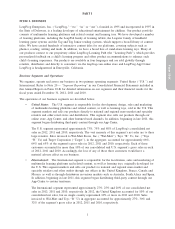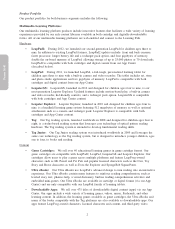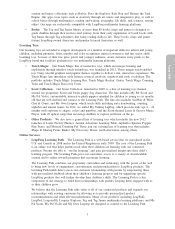LeapFrog 2012 Annual Report Download - page 19
Download and view the complete annual report
Please find page 19 of the 2012 LeapFrog annual report below. You can navigate through the pages in the report by either clicking on the pages listed below, or by using the keyword search tool below to find specific information within the annual report.
We rely on a small group of retailers that together accounted for the vast majority of our gross sales
each year so economic or other difficulties that affect these retailers or changes in their purchasing or
related decisions could have a significant impact on our business and operating results.
Our top three retailers in 2012 were Wal-Mart, Toys ‘‘R’’ Us and Target, which accounted for approximately
66% of the U.S. segment’s gross sales in 2012 and 64% in 2011. In addition, Wal-Mart and Toys ‘‘R’’ Us
accounted for approximately 27% of the international segment’s gross sales in 2012 and 30% in 2011. For the
foreseeable future, we expect to continue to rely on a small number of large retailers for the majority of our
sales domestically and abroad.
We do not have long-term agreements with any of our retailers and retailers make all purchases by delivering
one-time purchase orders. As a result, pricing, shelf space, cooperative advertising or special promotions,
among other things, with each retailer are subject to periodic negotiation and alteration.
We rely on our retail customers to successfully sell our products to consumers. Economic and other factors
that adversely affect retailers, such as increased competition from online retailers, liquidity problems, reduced
access to credit, inability to raise capital, reduced sales, consolidation in the retail sector and store closures,
bankruptcies and lower consumer confidence may also adversely affect us. For example, the bankruptcy of one
of our customers in 2012 resulted in bad debt expense of approximately $3.1 million. If any of these retailers
reduce their purchases from us, materially change the terms on which we conduct business with them or
experience a downturn in their business for any reason, our business and operating results could be
adversely affected.
If we are unable to compete effectively with existing or new competitors, our sales and market share
could decline.
We currently compete primarily in the learning toy and electronic learning-aids category of the U.S. toy
industry and, to some degree, in the overall U.S. and international toy industry. We also compete, and may
increasingly compete in the future, with makers of popular tablets, smart mobile devices and mobile game
platforms. Each of these markets is very competitive and we expect competition to increase in the future. For
example, in 2012 our LeapPad products faced competition from several tablets designed for children and from
general-purpose tablets made by major electronics manufacturers. Many of our direct, indirect and potential
competitors have significantly longer operating histories, greater brand recognition, and substantially greater
financial, technical and marketing resources than we do. These competitors may be able to respond more
rapidly or more successfully than we can to changes in consumer requirements or preferences or to new or
emerging technologies, and they may be able to use their economies of scale to produce products more
cheaply. Further, with greater economies of scale and more distribution channels, they may be successful even
if they sell at a lower margin. Our larger competitors may also be able to devote substantially greater
resources, including personnel, spending and facilities to the development, promotion and sale of their
products than we do.
Our business is highly seasonal, and our annual operating results depend, in large part, on sales relating
to the brief holiday season.
Sales of consumer electronics and toy products in the retail channel are highly seasonal, causing a substantial
majority of our sales to retailers to occur during the third and fourth quarters. Even though we achieved net
income for the fiscal year ended December 31, 2012, we incurred losses in the first and second quarters of
2012. Approximately 75%, 79% and 76% of our total net sales occurred during the second half of fiscal years
2012, 2011 and 2010, respectively. A decline of net sales, in the third or fourth quarter in particular, will have
a disproportionate negative impact on our results for the year and can lead to ongoing weakness in sales to
retailers well into the following year. Therefore, we may be significantly and adversely affected, in a manner
disproportionate to the impact on a company with sales spread more evenly throughout the year, by
unforeseen events such as economic crises, strikes, earthquakes, terrorist attacks or other catastrophic events
that harm the retail environment or consumer buying patterns during our key selling season.
11
























